Antarctica is considered by numerous wildlife photographers to be their Holy Grail. I know that both Paveena and I had been waiting many, many years to go. But to do so requires time and no small amount of money. In my previous job, taking three weeks+ off would have been difficult. However, my current sabbatical status has meant that time is not an issue and indeed this was the first trip that I booked when I realized early in the year that I would be having an extended (permanent?) leave of absence from the drudgery of the financial world. Paveena has a very generous boss who gave her the time off work. Despite the drama that unfolded during the trip – which was to receive international media coverage – both of us can convincingly conclude that this was the best photo trip that we have ever been on. Notwithstanding the future damage to our wallets, it has certainly whetted our appetite for more of the frozen continent.
One of the newer destinations in the Antarctica is Snow Hill. Surrounded by sea ice for most of the year, Snow Hill lies on the eastern side of the Antarctic Peninsula, in the Weddell Sea. In 2004, a breeding colony of 3,000 Emperor Penguin pairs was discovered in this remote location, accessible only by a combination of icebreaking ship and helicopters.
While some Antarctic trips leave from the south island of New Zealand, the majority leave from either Stanley in the Falkland Islands or Ushuaia in Tierra Del Fuego at the very southern tip of South America. Our trip left from the latter. Ushuaia is about as far from Hong Kong as you could get and involves three plane journeys (HK-London-Buenos Aires-Ushuaia). We broke up the journey by spending two nights in Buenos Aires and two nights in Ushuaia.
Ushuaia is a picturesque, windswept town, facing the Beagle Channel and surrounded by snow capped mountains. We spent the first day exploring Tierra Del Fuego National Park and on the second, we climbed up to a glacier, high above the town. In the first image, a cross country skier, with zig zag ski tracks, can be seen in the lower left (much clearer in a higher resolution version).
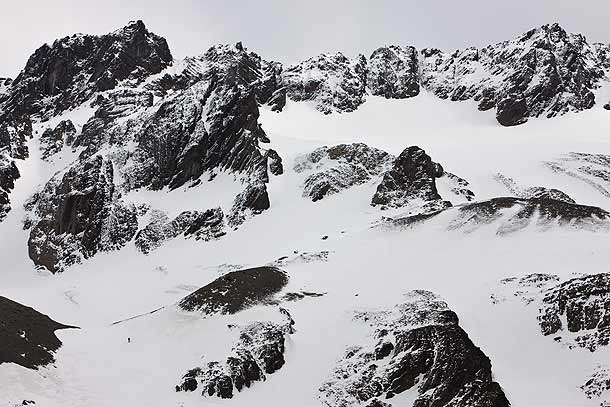
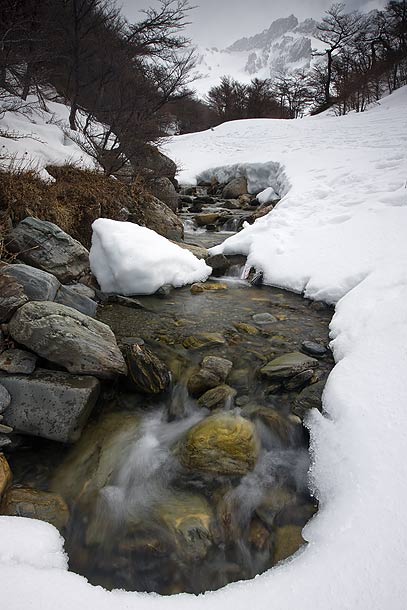
On day three we boarded the Russian ice breaker, Kapitan Khlebnikov late in the afternoon along with 100 other passengers. As the sun began to set, we headed down a flat calm Beagle Channel with snow covered mountains on either side.
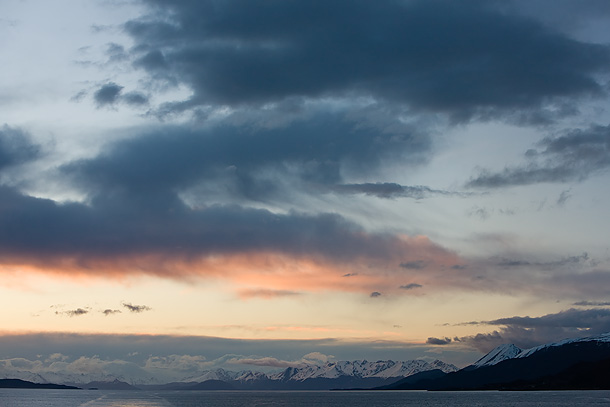
At around 2am, the ship began to take on an uneasy rolling motion with the pitch steadily intensifying. Loose objects in our cabin crashed against the walls and sleep became impossible. We had entered the Drake passage and now faced two days of “Drake shake” .
The Drake lies between the tip of South America and the Antarctic Peninsula and with no land at these low latitudes to temper the wind, is subject to near constant rough weather. An ice breaking ship has a relatively shallow hull ensuring little stabilization in the face of rolling seas while our eighth floor cabin (above deck) helped to further accentuate the rocking motion.
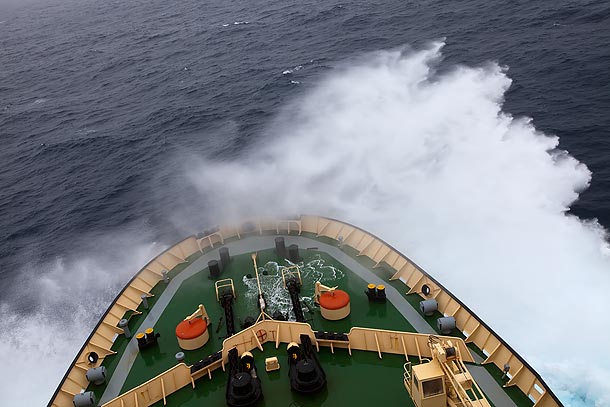
Next morning, a third of the ship’s passengers failed to show up for breakfast having succumbed to sea sickness. Fortunately, neither Paveena nor I have ever suffered from this debilitating ailment – which has made our scuba diving trips much more enjoyable – but I feel for those that do suffer. While there are pills and patches to help, once you are afflicted there is really very little that you can do other than lie prone in your cabin with your eyes shut.
However, lying in ones cabin was not where you wanted to be given the posse of majestic seabirds that were trailing the ship. These included several species of albatross (Black Browed, Light Mantled Sooty, Southern Royal and Wandering). And for a period in the morning, the sun even came out. The first photo shows a Giant Southern Petrel harassing a Black Browed Albatross; the second, another Black Browed flying above the spume of a breaking wave with a Cape Petrel below it; and the third, a Light Mantled Sooty Albatross, shot using a slow shutter speed (1/30th) and panning with the bird.
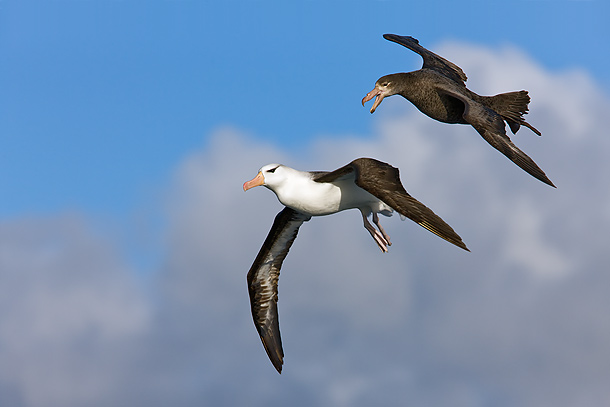
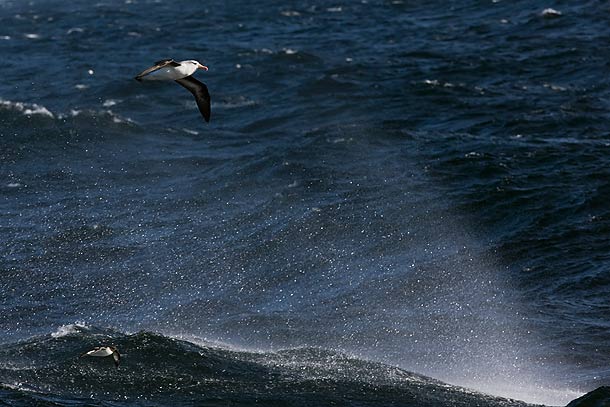
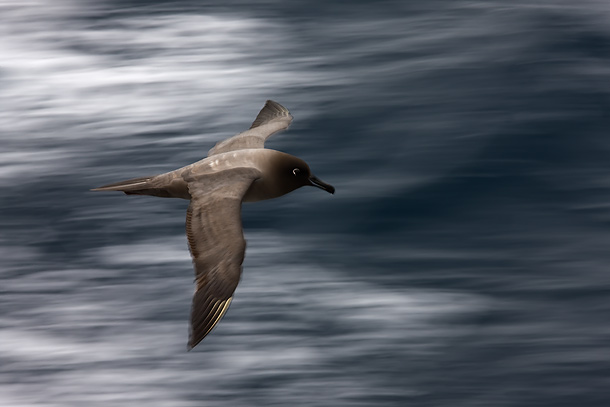
By the afternoon, the sun had disappeared, hidden behind a brooding, charcoal sky. Horizontal rain lashed the decks and the increasingly frigid air was mixed with spray from the mounting seas. Yet still the albatrosses followed the ship, seemingly oblivious to the inclement conditions. They almost looked to be having fun as they glided and swooped down between the crests of breaking waves.
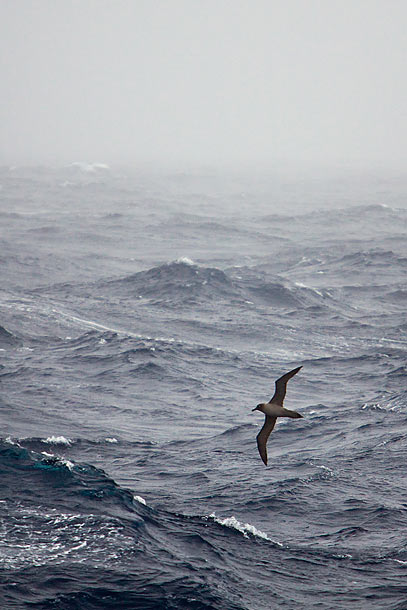
Although our preference is nearly always to go on solo photo trips or in very small numbers where we have total control over what we do each day, this is clearly not possible to a destination such as Antarctica. However, one of the upsides is that you usually get to meet extremely interesting people with similar passions and interests. With due respect to the people I worked with in finance, I cannot tell you how refreshing it is to meet and interact with people with like minded interests – in contrast to those whose sole interests are materialistic in nature and whose conversations seem to be limited to coma inducing topics such as the latest BMW series model or whether the equity risk premium for such and such should be 5.0% or 5.5%.
Among the colorful characters on the boat were Nigel from Cumbria in England, who had cashed in his building business in the UK and now leads wildlife expeditions in Northern Europe and the Arctic areas. Nigel has a special passion for seabirds which has taken him to some of the remotest corners of the globe. Then there was Dave, a specialist aerial cameraman and part of a three man BBC Natural History unit film crew who were joining the trip to film Emperor Penguins for a segment of a new, mega documentary, “The Frozen Planet”. Dave is a former social worker who became a freelance photojournalist covering many of the wars of the 1980s and 1990s in some of the world’s most unforgiving environments (eg Sudan, Iran and Iraq). After being shot at once too often in Sudan, he gravitated towards wildlife film making although the environment in which he has made a name for himself (Antarctica) is every bit as challenging as those that he encountered in his previous job. Listening to his accounts of filming at the Russian base of Vostok (home to the world’s lowest ever recorded temperature: -89 degrees c) where only 10-15 seconds of filming was possible at any one time was really inspiring stuff. Dave has pioneered the use of gyro stabilized aerial photography and was responsible for most of the Antarctic aerial footage in the groundbreaking “Planet Earth” series.
Also onboard was Mark, who along with his wife, are probably the two premier producers at the BBC Natural history unit. He has spent a good deal of the last two years helping to film chimps in places such as the Congo and the Ivory Coast. We were enthralled by his accounts of the various diseases and viruses that he has contracted during his time in the rain forests of these territories. I have a morbid fascination for parasites – well you name it, and Mark’s body has played host to it. My favorite story involved one of his camera men, who shortly after arriving back in the UK following a prolonged stint in West Africa, found that one of his testicles had swelled to the size of a grapefruit. He managed to drive himself to hospital and despite being in extreme discomfort could not resist this gem when the medical staff made their first examination: “Doctor, I think one of my testicles has shrunk”.
Anyway, after another white knuckle ride of a night, the seas began to ease the next morning as we approached the Antarctic Peninsula. Of particular excitement for us, was the appearance of the first sea ice. As we sailed further south, the temperature dropped and icebergs of increasing size began to appear. It’s hard to describe just how beautiful these icebergs are, especially the ones with a turquoise tinge – the result of red light being filtered out by ice that is densely packed together. For me, even if we had seen zero wildlife, the trip would have been made by the ice.
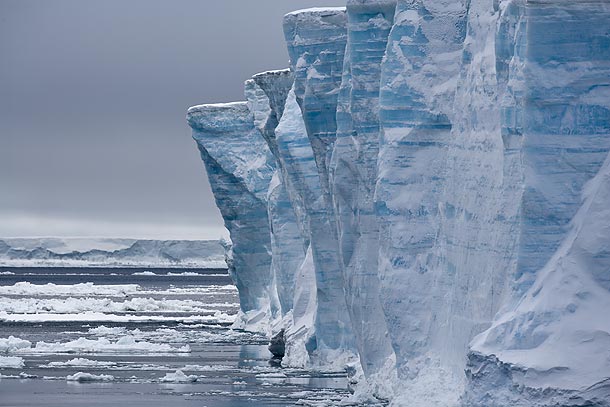
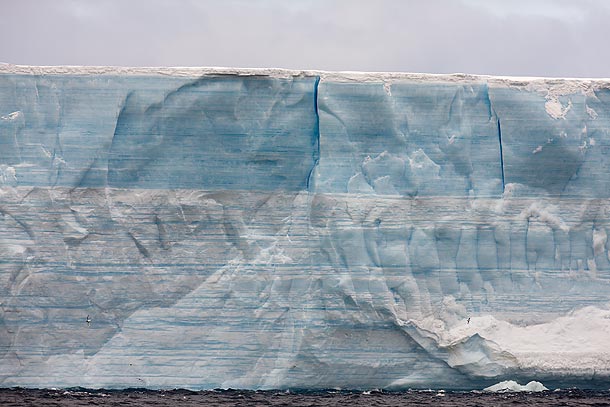
In the above picture, you may just be able to pick out the Cape Petrels in the bottom left and right of the picture (again much clearer on a high resolution version) which helps to give some sense of scale to these icebergs.
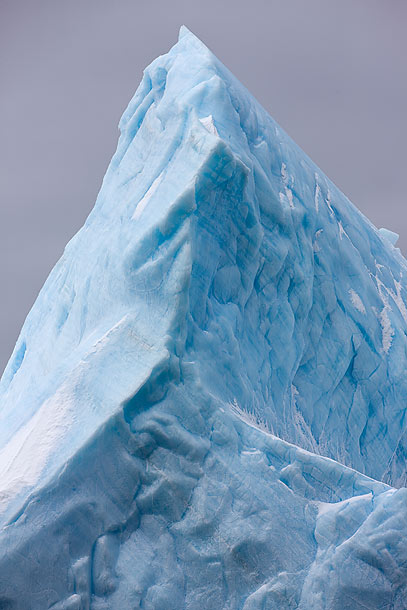
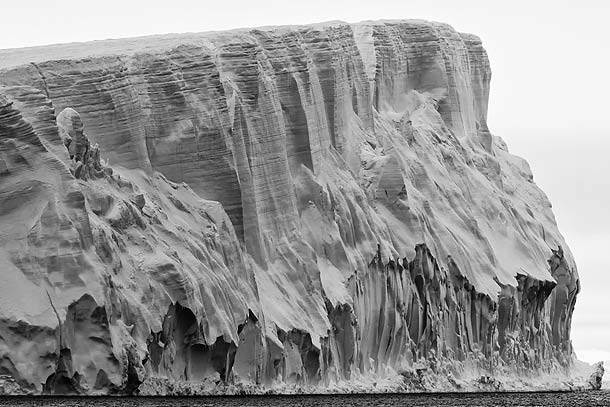
As the day progressed, the sun came out, the clouds disappeared, the wind dropped and the sea turned mirror calm. Without question, this was the most stunning landscape that Paveena and I had ever encountered.
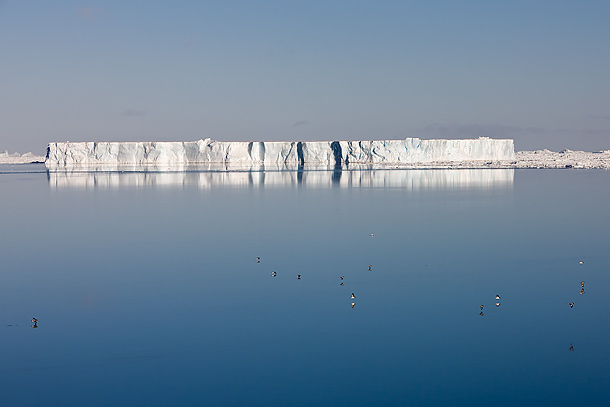
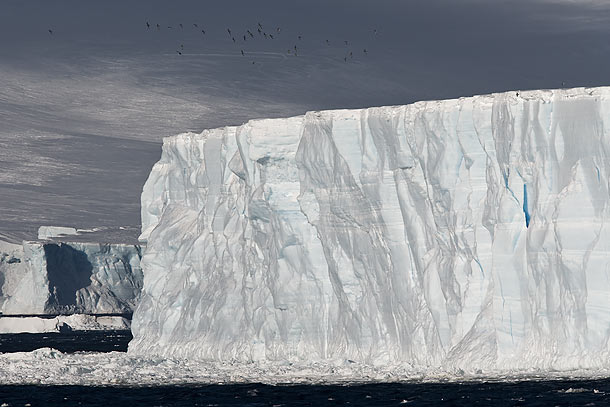
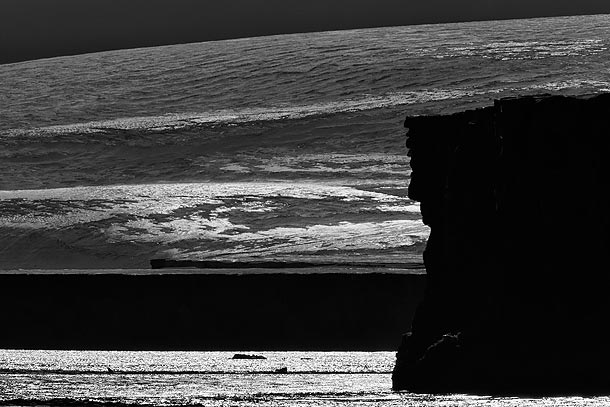
As the day lengthened (the sun was now setting at 11pm and rising at 3am) and as the ship pushed steadily south, the sea ice began to increase. Our ship was now doing what she was designed for: breaking ice. The next picture shows one variety – pancake ice.
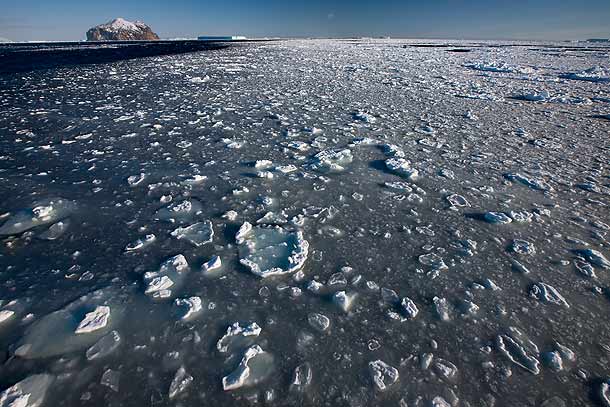
At 4am the next day, Paveena and I were back on deck along with a few other dedicated photographers. With the temperature at -10 degrees centigrade and the wind chill in the mid-20s, we were now dressed like Michelin men – thermal undergarments , fleeces, 800-fill down jackets with hood, wool hats, neck warmers which we pulled up to cover our mouths and noses, gloves and mitts. The latter have to come off to operate a camera leaving only a thin pair of gloves underneath. And this turned out to be the biggest photographic challenge of the trip – keeping the ends of one’s digits sufficiently warm to use a camera.
Fine weather rarely lasts more than a day or two in the Antarctic and the new day found dark clouds ringing the horizon. A pale, yellow sun was rapidly fading but did briefly provide some beautiful lighting conditions.
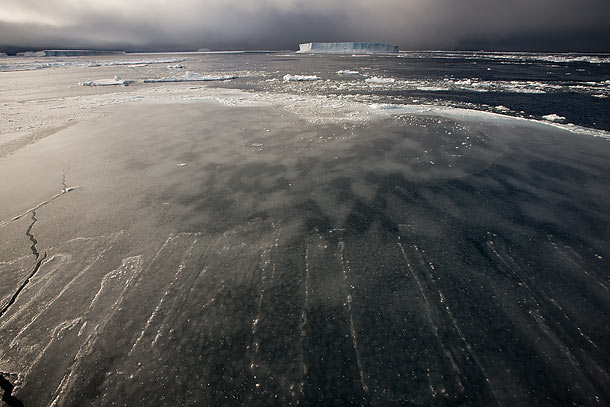
Soon though the light turned monochromatic, the effect of which can be seen in the next image. This looks like a doctored photo (eg photo shopped with the colour removed) but this is pretty much straight out of the camera with minimal processing.
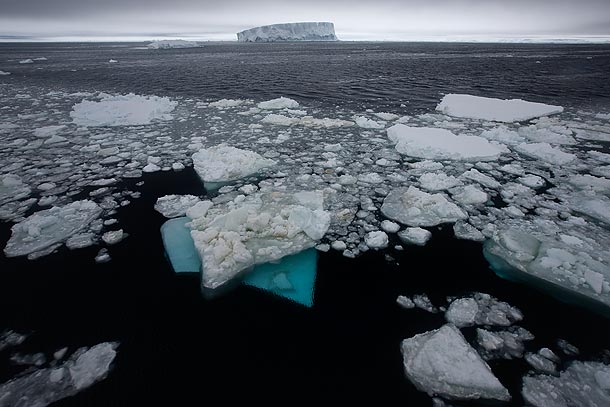
As we neared our destination (12-15 miles from Snow Hill), we began to encounter thick pack ice. At the same time we were seeing more and more wildlife, especially penguins. We were especially thrilled to see our first Emperors. Again, this next image looks much better as a high res photo with the penguins standing out more clearly.
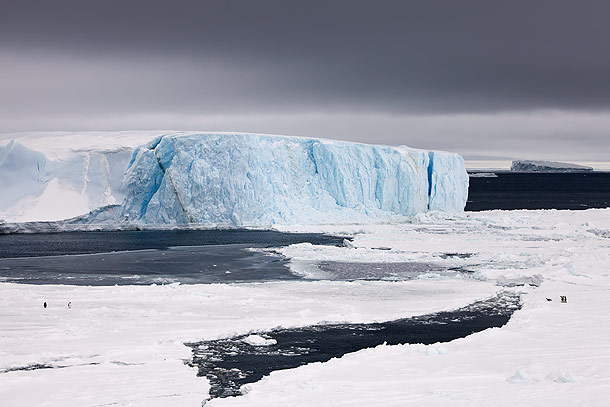
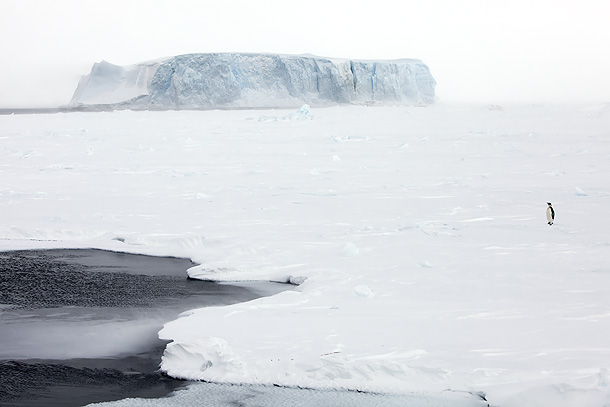
An announcement was made shortly thereafter that we had reached our “garage”. The captain literally parked the ship in some fairly solid pack ice and this was to be our home for the next four days. The bad news was that visibility had dropped with little delineation between land and sky and hence, at least for today, we would be unable to reach Snow Hill by the two Russian helicopters that the ship carried. The good news though, was that we would be able to get off the ship onto the surrounding ice. We were already seeing periodic lines of Emperor Penguins returning from fishing trips to the Penguin rookery.
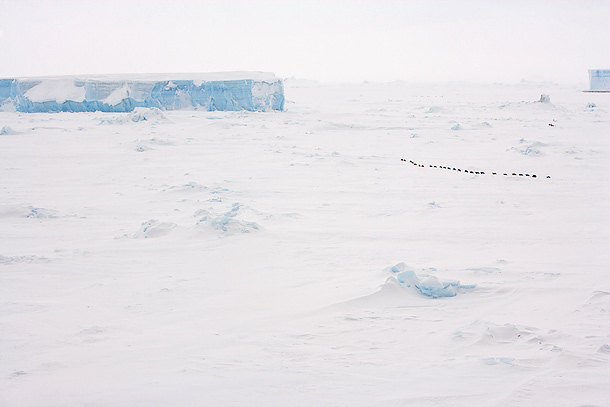
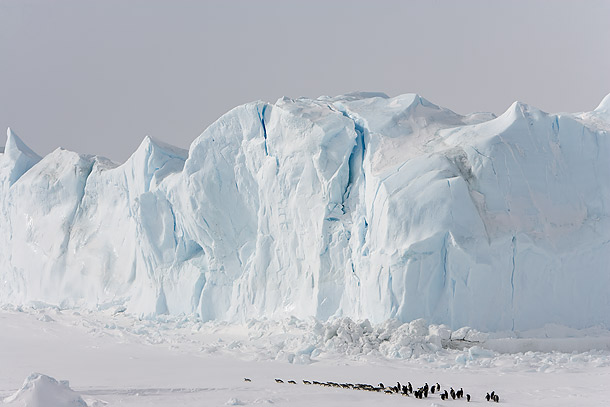
By the time we got off the ship in mid-afternoon, blizzard like conditions had set in and it had become seriously cold. After two hours out on the ice, my fingers had become so frozen and numb to the point where I could no longer push the shutter button of my camera. At one point I was reduced to using my little pinkie as this was the only digit that was responding to my efforts to perform the simple task of depressing the shutter. However, despite the pain that I suffered when my fingers began to warm up back on the ship – indicative that frost bite would have begun to set in had I stayed out much longer without my thick mitts – it was a thrilling experience to get our first on the ice, face to face encounters with penguins.
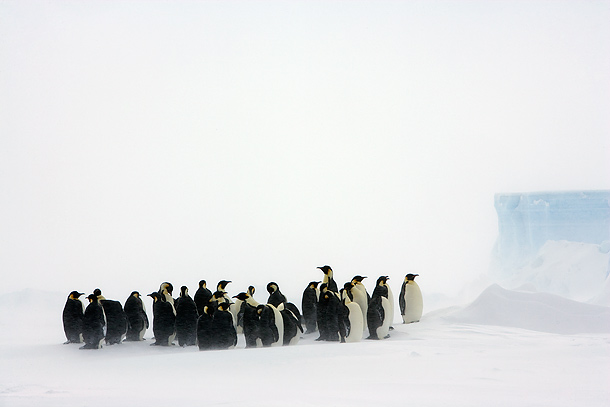
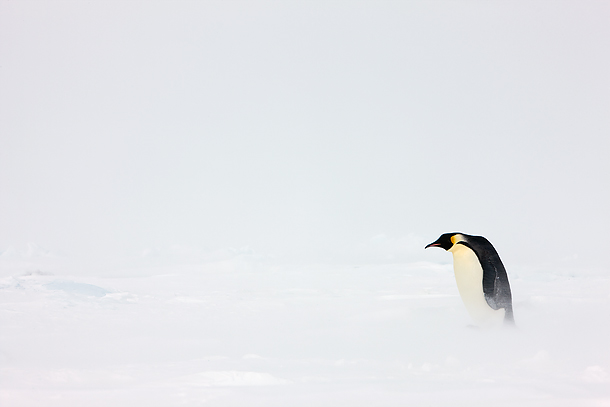
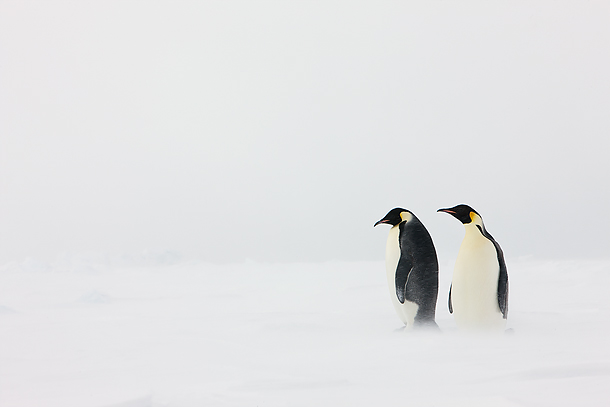
While Penguins look almost comical when they walk in their distinctive waddle style, most of their ice travelling is done toboggan style, on their bellies using their hind legs and side flippers to propel them. They are surprisingly fast when they adopt this method which is just as well given the round trip of some 30 miles to and from the rookery.
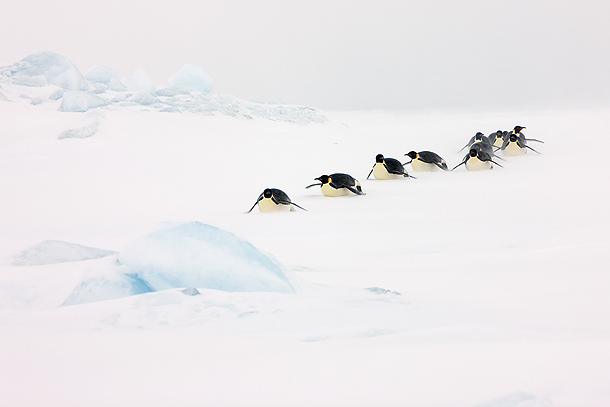
Aside from the Emperors, there were also a few Adele penguins on display also showing off their toboggening skills.
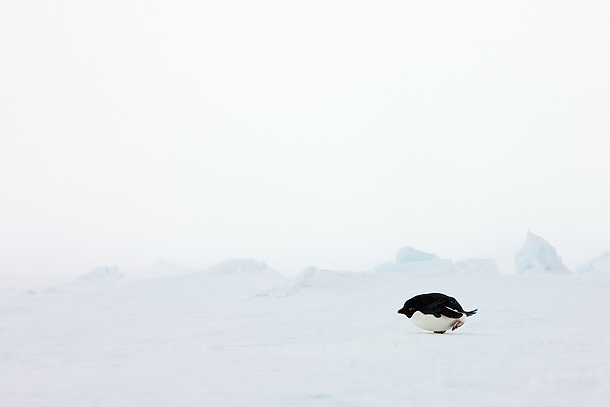
Paveena stayed with the BBC film crew and took this picture of Dave filming a curious Emperor in near white-out conditions.
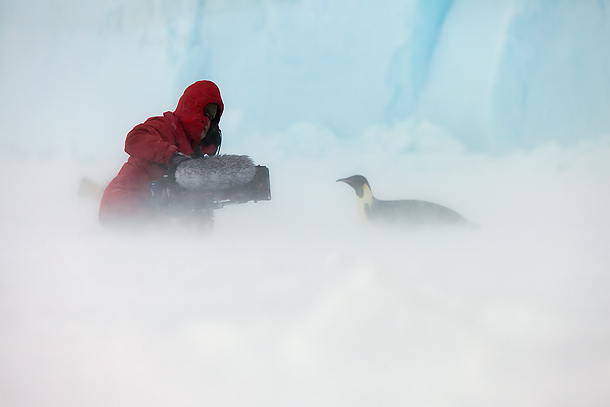
We awoke the next day to a continuation of the blizzard conditions. These prevailed all day ruling out any possibility of reaching Snow Hill. However, we were able to get down on the ice again. In addition, the captain had run the propellers at the stern of the ship to create an open patch of water. As the only piece of open water for several hundred meters, this attracted a plethora of wildlife including Minke whales, Crab eater seals and Emperor Penguins. The penguins were now using this stretch of water to launch themselves onto the ice as the starting point for their long march back to the rookery.
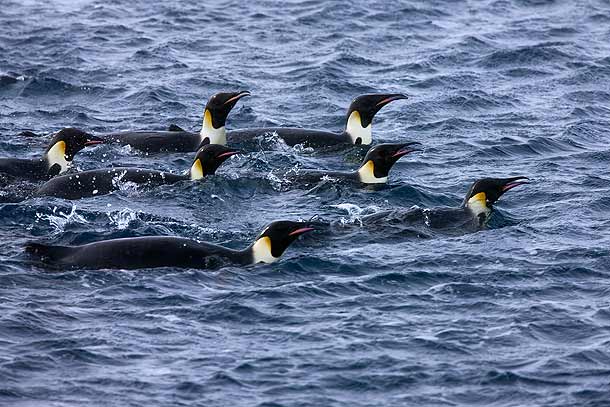
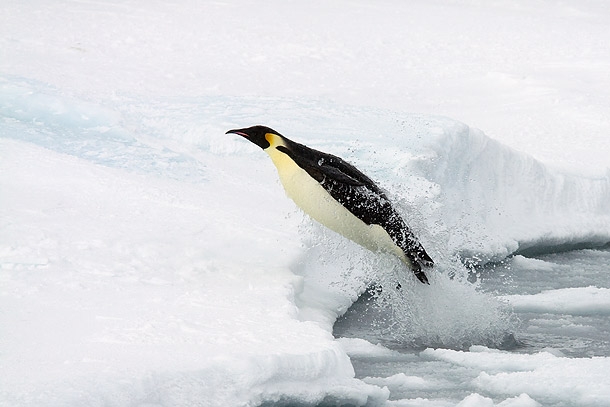
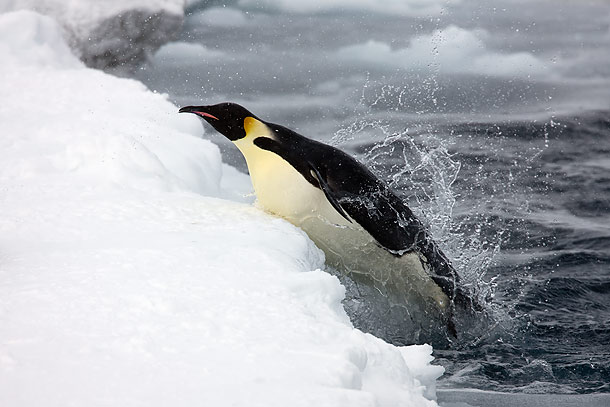
We were again able to spend time of the ice. Here is an inquisitive Crab eater seal…
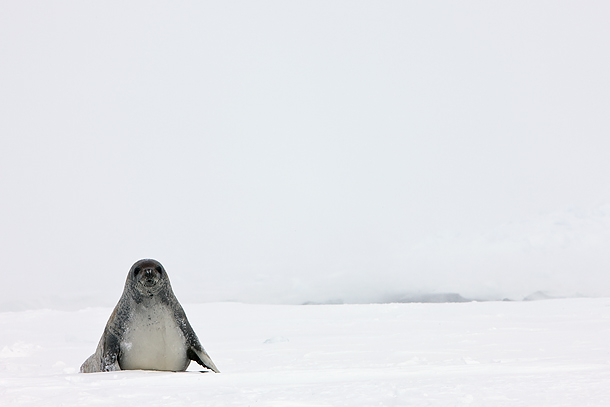
…and more Emperors huddled together during a brief stop on their journey back to the rookery.
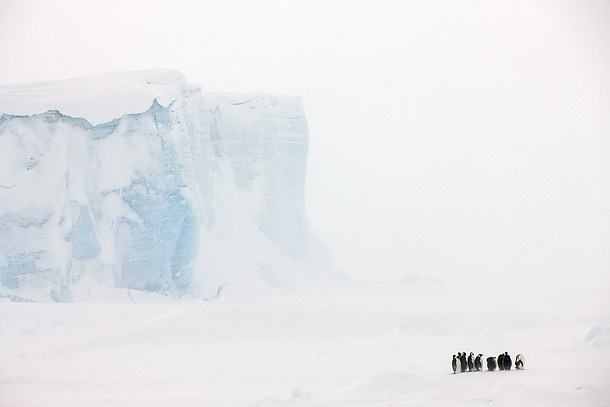
The third day at the “garage” found the weather, if anything, even worse than the previous two days. Any possibility of reaching Snow Hill was thwarted. It was also noticeable that the incessant wind had blown more and more pack ice in our direction. Save for the small opening at the back of the ship – kept open by periodic churning of the ship’s propellers – all site of open water had now disappeared. We were well and truly wedged into the ice.
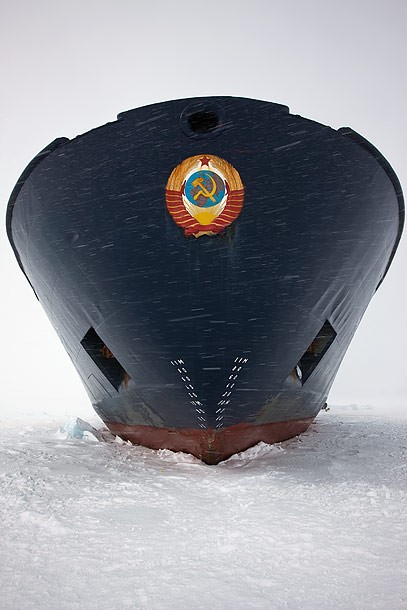
At mid-morning on the fourth day at the garage, with weather conditions unchanged from the previous day, all of the guests were summoned to the ship’s auditorium. The leader of the expedition informed us that he had been called to the ship’s bridge early in the morning by the captain. The latter had shown him a series of short and long range weather forecasts and satellite maps of current and forecast weather conditions. The news was not good. A new storm system was closing in on our position and we must try to leave immediately before more pack ice was blown our way.
A mood of despondency hung over the ship as the realization dawned that the chances of reaching the rookery were now exceedingly slim. In eleven trips to Snow Hill, this would mark the first time that passengers had failed to reach the rookery for at least one day. The plan was instead to reach some of the Weddell Sea islands where colonies of other species of penguins existed. Ordinarily, this would have still been an exciting prospect but given the alternative that we now looked to be giving up – 3,000 breeding pairs of Emperor penguins with their impossibly cute chicks – it was hard not feel let down.
Shortly thereafter, the ship’s engines started up and we began to reverse through the ice. Progress though was pitifully slow and after four hours, we had limped no more than 300 meters. At this point, the engines were switched off and we came to a halt before more pack ice quickly drifted in and secured us tightly on all side. An announcement then came over the ship’s intercom that the main rudder had developed a problem and would need to be fixed.
This took another 4-5 hours. An attempt was made to exit our position but to no avail. Not only had the prevailing winds blown several kilometers of pack ice in our direction rendering us well and truly stuck, but visibility had dropped to less than 50 meters. This made it impossible for the captain to see and locate possible leads in the ice that would lead to open water or easier ice conditions.
That evening we were told that until the current south-westerly winds changed direction, which in turn would loosen the pack-ice, the ship was effectively immobilized. Disturbingly, we were informed that it could be 4-5 days before the winds turned. Moreover, the ice that now lay around the immediate vicinity of the ship was deemed to be unstable, ruling out any further ice excursions.
Late in the evening, visibility did improve, but the wind and snow showed no sign of letting up. This next image was taken from our cabin window using flash set to rear curtain-sync. The effect is to give the falling snow a meteor like effect.
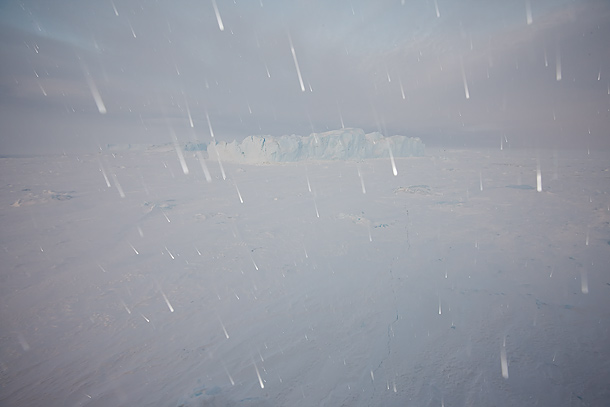
For the next three days, weather conditions remained unchanged. We settled into a pattern of sleeping, eating vast quantities of food and occasionally venturing outside to view the numerous seals that lay about the ice in close proximity to the ship and to watch the lines of penguins on their seemingly endless round trips to the rookery. Avian life had all but disappeared save for several beautiful snow petrels that spent long hours circling the ship.
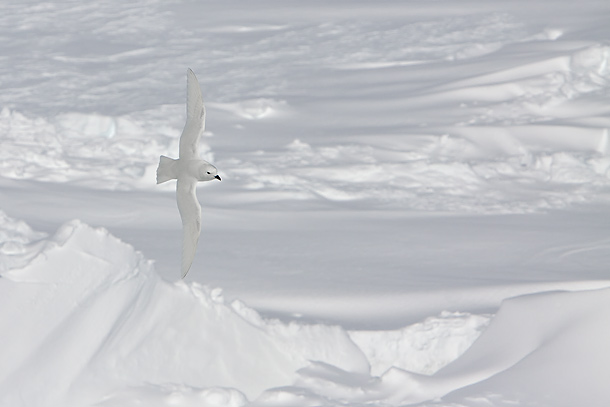
By now a mood of resignation had settled among the passengers. Not only were we going to miss our arrival date back to Ushuaia with resultant flight booking chaos but when we did break free of the ice, we would need to sail directly back to port thereby making any wildlife landings in other areas impossible. Gallows humor became the order of the day. Mock plans for seal hunting expeditions were drawn up and it was noted that our current location was within a day’s sailing of the spot where Shackleton’s ship “Endurance” had succumbed to pack ice (the additional irony being that a cousin of his was on board as a lecturer).
At an evening gathering of the passengers, the expedition leaders informed us that our predicament had now reached the attention of the international media who clearly were looking for a story of drama. As it was, we were in absolutely no danger; had food to last well over a month and had a truly first class crew to look after us.
The fourth day in our existing position saw a drop in the wind and a noticeable improvement in visibility. At lunch time it was announced that while conditions were such that reaching Snow Hill by helicopter was still impossible, it would be possible to make some short sight-seeing trips using the helicopters. We were split into 8 groups with each group enjoying 15-20 minutes in the air.
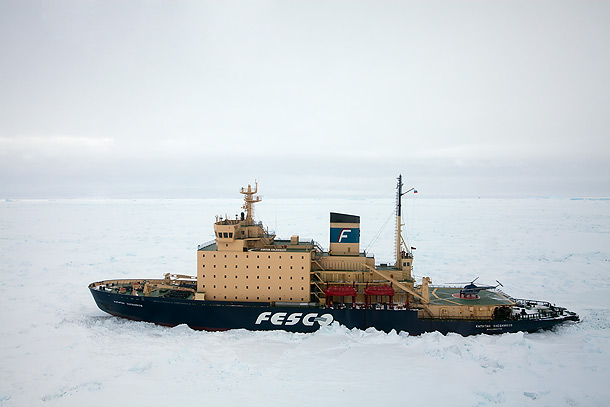
The next day again saw light winds and increasingly improving visibility. While the wind direction had begun to swing around, it was not yet at sufficient strength to blow the pack ice away from the ship. Then, late in the morning, with the sun beginning to peak out, came the announcement that we had not dreamed possible: the helicopters were now ready to fly to Snow Hill! Hardly anyone cared that due to the late departure, each group would have no more than 75 minutes at the rookery after allowing for a 60-90 minute round trip commute from the landing site to the rookery.
Our group was the second last to depart. This turned out to be a stroke of good fortune. By the time we departed it was 4.30pm. The white, featureless sky had given way to a brilliant blue and lighting conditions for photography promised to be excellent as the sun sunk lower.
After 15 minutes in the air, flying over a stunning landscape of iceberg dotted ice, we spotted the rookery which can be seen in the upper left of the following image. The track marks are the trails used by the Emperors to travel to/from the rookery.
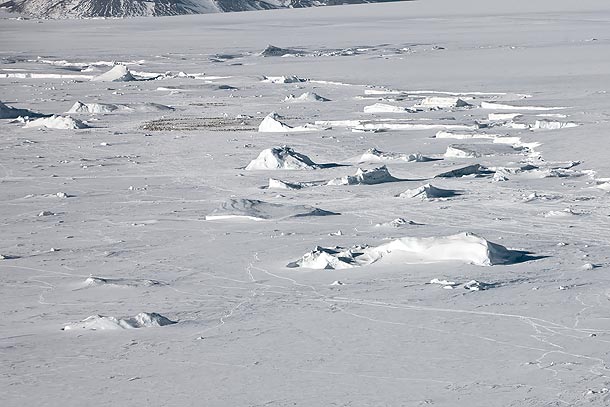
The landing site is located a little over a mile from the rookery and hidden behind a large iceberg in order to minimise disturbance to the penguins. A mile might not seem like a lot, but with a heavy pack containing all of one’s photographic equipment and snow that varied from 3 inches to 3 feet in depth, the going was arduous. A number of older and out of shape passengers were told to turn back after it was decided by the expedition staff that they were taking too long to complete the walk (the logic being that they would have little or no time at the rookery if they were to make the return journey in time to board their pre-assigned helicopter).
Being finely tuned athletes (mmmm) meant that the walk proved little trouble for Paveena and I although by the time I reached the rookery, I was sweating buckets and had stripped down to a thin thermal under layer.
Like many of my fellow passengers, I was gripped by a sense of panic upon reaching the rookery. I had a little over one hour but what was I to take pictures of? It might seem difficult to understand, but while the possibilities seemed endless, where to start was the problem. I might never get back here. Should I stick to one spot, bide my time and try and get 1-2 decent pics or should I simply adopt a scattershot approach and try to get some images just to have a record that I was here? In the end, it seemed as if I did neither and aside from the following wide-angle image of the colony, I pretty much came away with nothing acceptable.
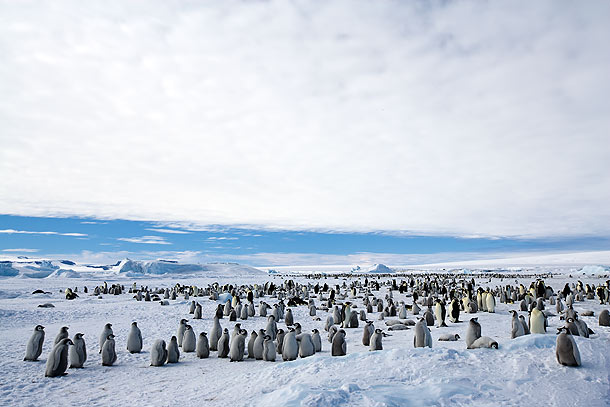
Still, as I waited for our helicopter to take us back to the ship, it was hard not to have a feeling of euphoria at having finally made it.
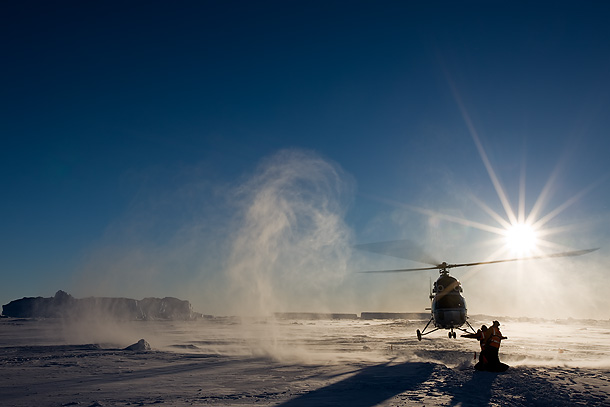
But things were to get even better. At 6am the next morning the following announcement came over the ship’s intercom: “Well the bad news is that winds remain light with no change in the pack ice conditions, so we remain firmly fastened in the ice…but the good news is that there is not a cloud in the sky which means…a full day at Snow Hill!”.
You’ve never seen two people out of bed quicker that morning. By 8am we were on our helicopter flying towards Snow Hill. The walk in was easier today as the snow on the “path” to the colony had been packed in following the numerous passengers that had traversed the route the previous day. Knowing that we would have plenty of time at the rookery, we took our time getting there. This allowed us to photograph some of the penguins heading back to the rookery as well as some of the amazing ice formations along the route.
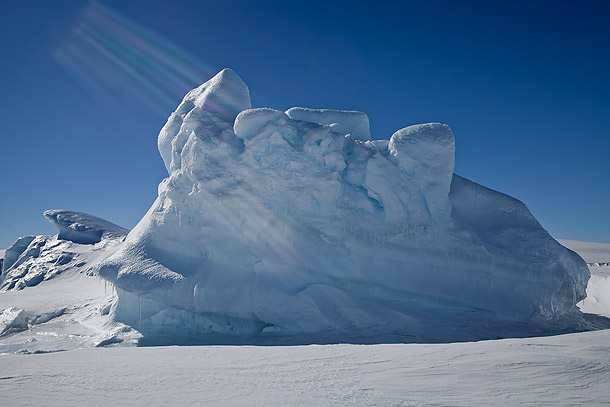
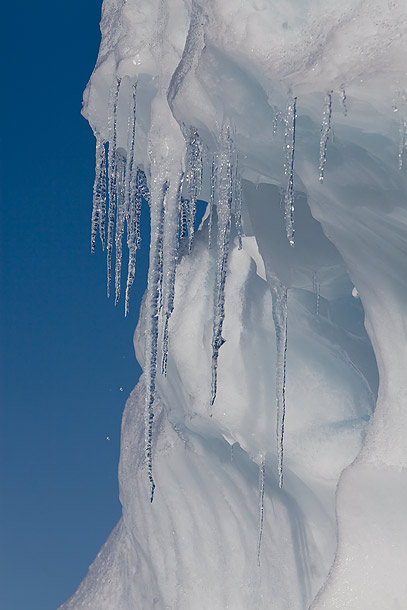
Once at the rookery, we felt none of the pressure of the previous day. For us, the most enjoyable days photographing wildlife are when you have plenty of time to simply sit and observe the wildlife. Once you get familiar with the behavior of the animals, your photos inevitably improve too.
Although we were all told to keep a respectable distance from the penguins, they would often approach us to within touching distance. I used my wide angle lens just as much as the telephoto one.
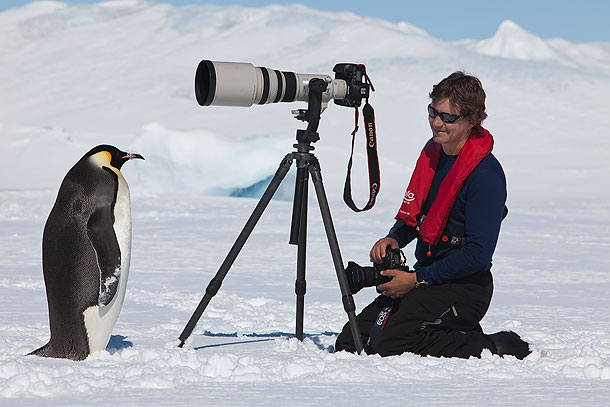
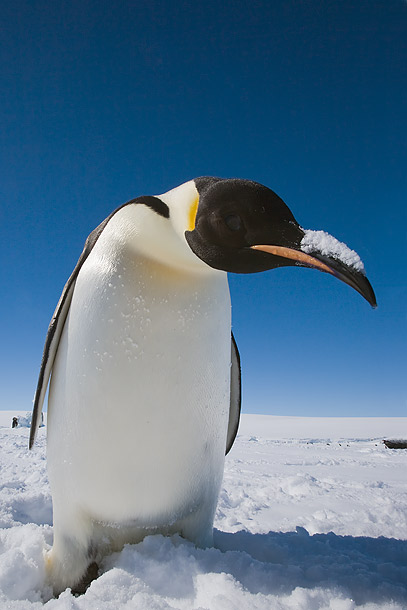
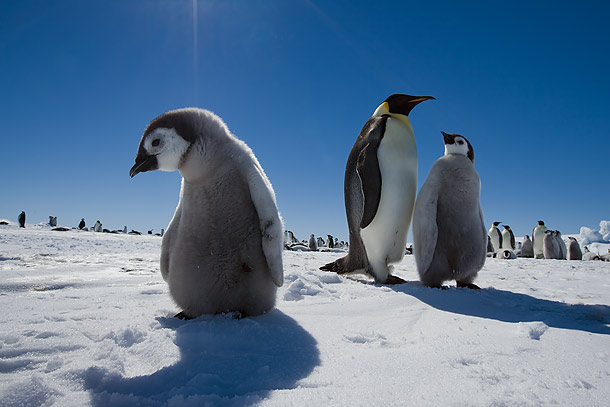
One of the difficult aspects of photographing the rookery with a telephoto lens is isolating your subject with a relatively clean background. It took a fair amount of patience, but the shots of the chicks interacting with adults (read: begging for food) eventually came together.
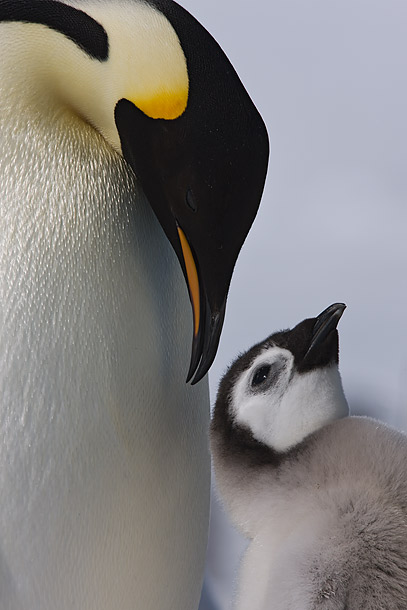
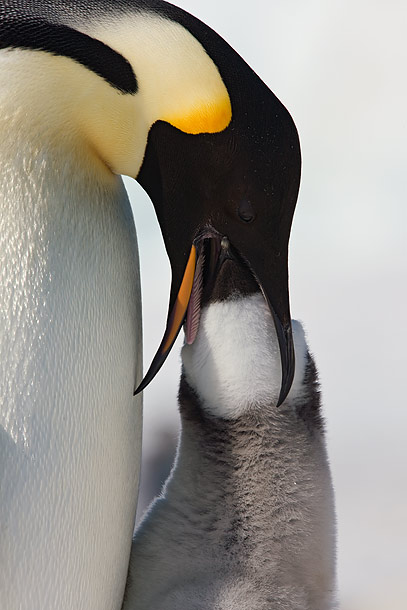
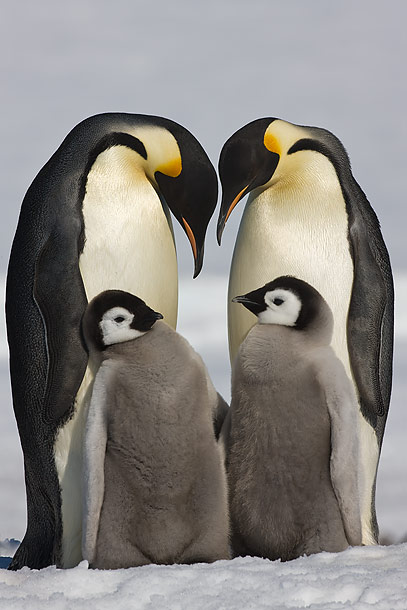
On our way back to the helicopter in late afternoon, I spied a single Emperor leaving the rookery. As it proceeded up a small hill, I positioned myself on the other side, where I noticed a series of tracks left by other penguins leading up to the top of the hill. The image turned out to be my favorite of the trip.
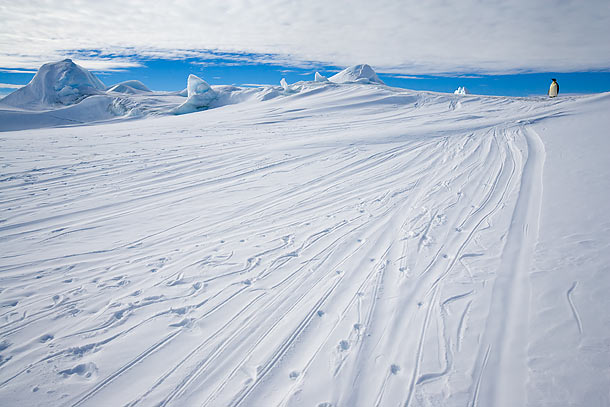
That evening, as the sun was setting, the sea ice surrounding the ship became enveloped in a layer of fog. The setting and the colours were the perfect way to round off probably the greatest day of wildlife viewing and photography that Paveena and I have ever had.
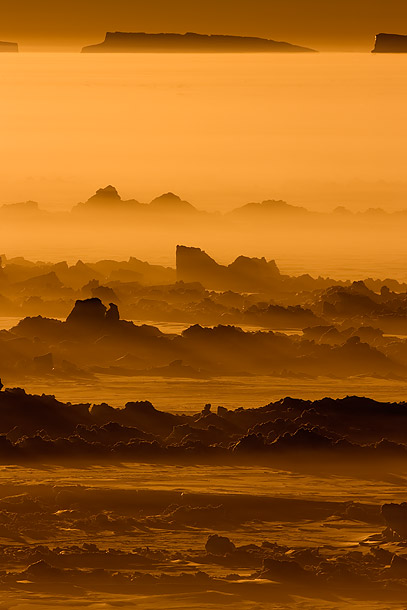
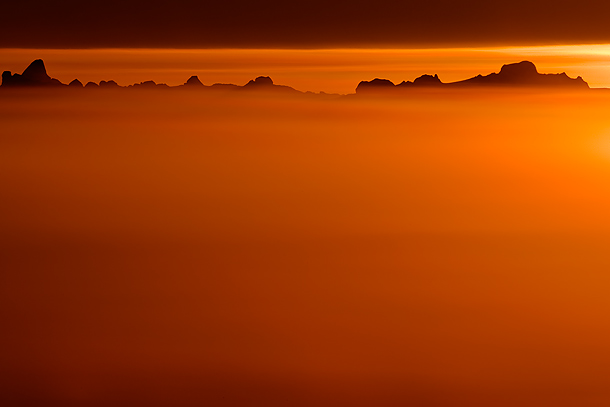
The next day produced yet another cloudless sky although the winds were beginning to strengthen. We were told that we would be able to get a half day in at the rookery. However, about a quarter of the passengers didn’t make it due to a combination of severe sunburn and snow blindness. The Antarctic peninsula sits right under the ozone hole and when combined with the highly reflective snow and ice, produces UV rays of incredible intensity – far greater than anything that I have experienced for instance in the various deserts of Africa that I have visited. 90% of passengers (and crew) suffered sunburn of varying intensities despite the use of very high factor sun cream. While my face was not too bad, my neck suffered badly and for 2 days had the appearance of a 2nd or 3rd degree fire burn. Even more unfortunate were those that had taken off their sunglasses for long periods. They now had extremely sore eyes with the only respite being to lie in a darkened cabin preferably with closed eyes.
After applying layers of factor 70 cream and covering up most exposed skin (fortunately it was a little cooler today), we were back at the rookery. Again, it was another fantastic few hours that passed all too quickly.
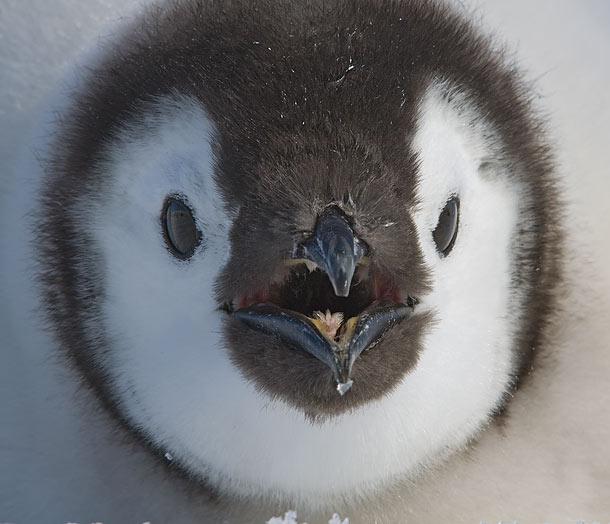
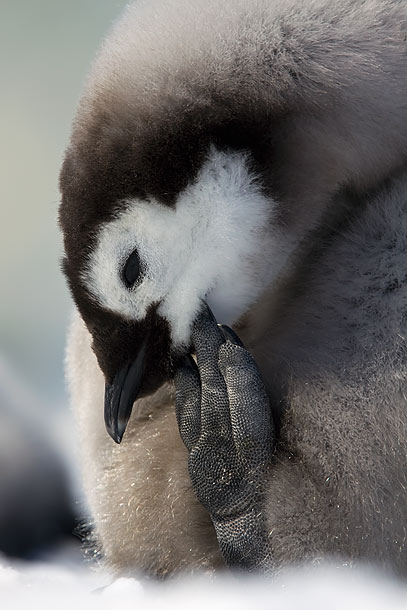
While penguins face many predators in the water, eg Orca whales and Leopard seals, their only real threat on land – and the threat is only to smaller chicks – comes from Skuas: large, voracious birds found in lower latitudes. I missed the shot of a lifetime when a Skua flew right by me with a penguin chick in its mouth. Here’s one minus a chick.
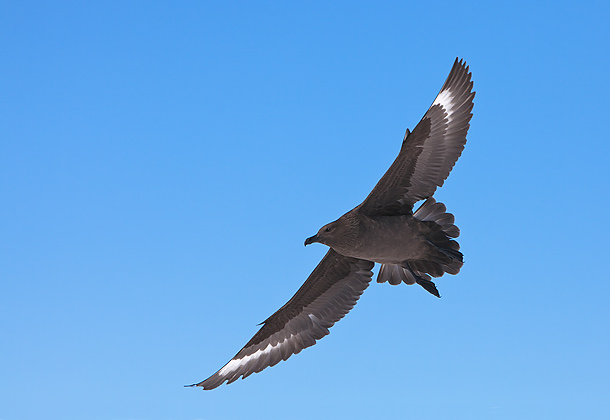
As the dawn broke the following day at 3am, the engines started up and the ship began the slow process of extracting itself from the ice. We were told that a change in and a strengthening of the wind had dispersed some of the pack ice although to the untrained eye there appeared little improvement. At first we made very little progress but with the visibility still good, the captain was able to use the ship’s helicopter to reconnoiter for leads in the ice.
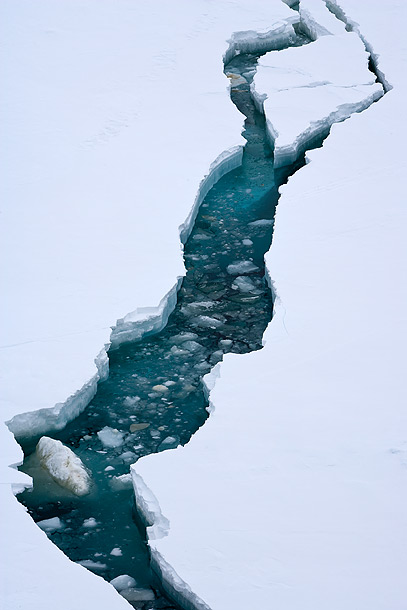
As the day passed our progress improved. The ice thinned out and we began to get into stretches of open water. With the onset of evening, we finally reached unbroken open water.
The Drake passage was hit that night with seas that were even worse than the outward passage. Sleep was nigh impossible. Fortunately, with the ship sailing at full speed, we entered calmer waters by the following evening and by night had entered the flat calm Beagle channel. In the early hours of the morning we docked at Ushuaia.
All in all, it had been an unbelievable trip; something that will remain long in our memories. We are already scouring the web for another voyage to the Antarctic next year,
A final mention should go to the expedition organizers, Quark and Exodus. Both were extremely professional in handling the rebooking of flights etc. Quark even chartered an entire aircraft to take us back to Buenos Aires and provided accommodation in a 5 star hotel in the city at zero cost to us. We would unequivocally recommend them to anyone that is contemplating a polar trip.
Finally a picture of Paveena, framed against a beautiful iceberg at the helicopter landing site near to Snow Hill. As you can see from her clothing, she was anxious that I did not lose sight of her….
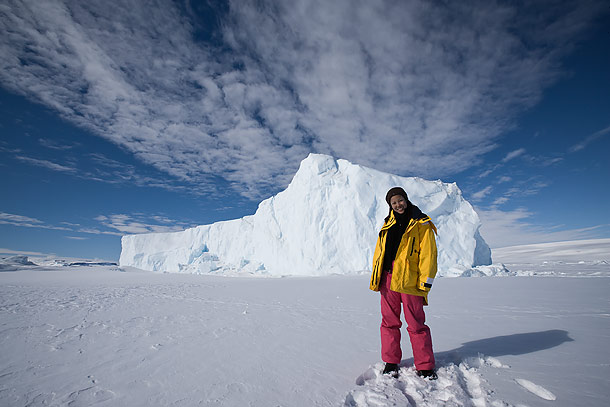
Ross McKenzie
December 19, 2009
Love it Paul. A brilliant read! Puts a whole new perspective on “March of the Penguins.”
Ross
Wliu
December 22, 2009
excellent experience! it is absoutley worth to travel
Aloa
December 25, 2009
Love the blog and photos! Amazing!!! So inspirational and fascinating, I feel as if I were there. One question though, why are the icebergs blue? 🙂
Grace Wong
December 26, 2009
breathtaking photos and a beautiful account. I’m happy you’ve finally started turning your passion and amazing talent into something more than a hobby.
joel
December 30, 2009
Truely remarkable! Absolutely stunning photographs!
Frances
January 20, 2010
What an amazing adventure! Loved reading every word and looking at every photo. Thrilled to learn you are now pursuing your heart’s desire ET!
Jia
January 28, 2010
you should put numbers on the posted photos.. so we can vote for the favourite ones!!! : )
i like the last penguin in yellow and pink! heeheee
Govind and Mimi
January 29, 2010
Absolutely gorgeous photographs! Truly stunning. So glad you are doing what you have always wanted to do.
Persefoni
July 1, 2012
Amazing photos and experience! Congratulations! may I ask with tele you used? Had any difficulties with the camera and cold? Any tips for shooting in such cold conditions? I am thinking of going to snow hill this november. Thanks in advance. Persefoni
Paul Mckenzie
July 9, 2012
For the Snow Hill trip, I mainly used a a Canon 500mm and a 70-200mm zoom. Elsewehere I use a 600mm lens a lot esp in Africa and Japan. In Midway I use a 300mm f2.8 lens a lot. Everywhere I use the 70-200mm and I like to shoot lots of wide-angle so my 16-35mm is also regularly used.